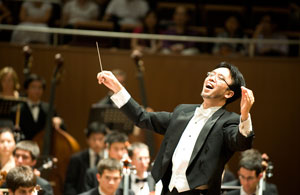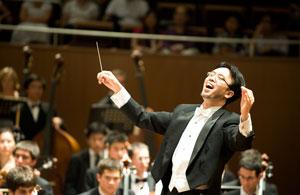
For his eighth annual Pan-Asian Music Festival next month, Jindong Cai, conductor of Stanford University’s symphony orchestra, will be celebrating the music and culture of his native China, as well as of that massive nation’s Asian neighbors, Korea and Japan. At his office in the campus’ Braun Music Center, next door to where most of the festival events are presented at the Dinkelspiel Auditorium, SFCV spoke with Cai about the festival’s origins and the discoveries he’ll be sharing this year.
You weren’t hired here to do Asian music, were you?
Not only that, but I was trained as a Western musician. When the [strictly anti-Western] Cultural Revolution started, in 1966, I was 8 years old. In Beijing, when the Cultural Revolution finished, I was just getting to college, and I was able to go to a Berlin Philharmonic concert, with von Karajan conducting, and a Boston Symphony concert, with Ozawa conducting, and those were very, very huge events back then. I was just amazed by the sound that a live orchestra could produce, so I said, “I have to go to the West to study conducting.”
And even with the Cultural Revolution, you hadn’t gotten much exposure to traditional music.
No. When you’re a conservatory student in China, you learn Western music. And somehow you look down on traditional music.
That still happens for some people here in the U.S.
So when I came here, I went to Tanglewood [Music Festival] to study with [Leonard] Bernstein, and I started to work with the Cincinnati Symphony as assistant conductor, and I guest conducted in Arkansas and Louisiana. But orchestra conductors always want to talk to the audience, and when I talked to the audience, people asked me questions always related to Chinese music! I talk about Brahms and Tchaikovsky, but they always say, “Why did you become a Western music musician? What about Chinese music?” And it inspired me to think, Yeah, what about it? I didn’t know that much.
So that’s what inspired you to start an Asian festival.
I had this idea long ago, but I worked at Louisiana State University’s School of Music in Baton Rouge for four years, and it was not possible to realize [it] in Louisiana. When I came to the Bay Area [in 2004], I said, “We’re living on the Pacific Rim, there’s lots of Asian people around here, so maybe we can start.” It started with very little, but now it’s already eight years.
Has the festival been an education for you?
Yeah, because each year we focus on either a country or a region or an art form or a theme. We had a year, 2006, when we focused on South Asia, and in 2008 we focused on China, because it was an Olympic year. This past year, we focused on Central Asia, so we had a Mongolian musician, Mongolian composer, and Mongolian band. This year we are focused on a theme — “Transforming Tradition” — and on Korea, China, and Japan.
Asian music ... is transformed by time, and by geography.
Tell me about the theme.
I’m not introducing contemporary Asian music; it’s music from contemporary Asia, which means that what Asian people are doing may be traditional, may be contemporary. What I intend to do is show the audience how Asian music has been transformed, in a different perspective. For one thing, it’s transformed by time, and by geography. For example, we’ve invited three Asian masters playing three different zithers. In China it’s called guzheng, in Japan koto, and in Korea gayageum. But all three came from the same root, thousands of years ago, from the Chinese guzheng. On Friday evening of the first weekend, I want each of the masters to do a half-hour solo. The musicians will introduce a little bit about the instruments and their history, and that way, people will learn a lot.
Will the repertoire be both traditional and contemporary?
Politics sometimes divides people, but in art and music you find connections.
Yes. I specifically asked each to pick pieces that represent the development of each instrument, representing different periods.
You’ve used the term “Elegant Gatherings” about your approach to presentation in past festivals.
It’s an ancient term, used in ancient China to describe when scholars and artists get together.
Like a salon?
Like a salon. They exchange ideas. They play instruments, recite poems, criticize politics; they do those together. I did this a couple of years ago, and now I feel we can expand this, to make it a whole lecture series. It will be three tea ceremonies. Tea came from China, and the tradition went to Korea and Japan. The Chinese is more loose, more about the tea itself. In Japan, it’s called “Way of Tea,” and it’s almost like a religion, Daoist or Zen. In Korea, they treat tea like a ceremony; you have to have this whole dress-up.
So you’ll have your audiences involved in tea ceremonies?
Well, I designed the “Elegant Gatherings” for between 50 and 100 people, so I hope it’s not more than that!
Is music involved?
The Korean ceremony, traditionally, always has a performance accompanying it, because it’s a ceremony. The Japanese [ceremony] is silent; only after or before the tea can you have music. And the Chinese [ceremony] is art, so the Tea Master has said; I’m going to have a calligrapher come, and a musician.
Where will your Tea Masters be coming from?
The Korean Tea Master is a professor in Korea, and he’ll bring some of his students. The Japanese Tea Master teaches about tea as a professor in the U.S. The Chinese Tea Master is from Taiwan, but now has a cultural club in the Bay Area.
Have the festivals had a connection to the curriculum at Stanford?
Each festival we’ve combined with academic activities, lectures and demonstrations, and master classes. We invited [Indian tabla virtuoso] Zakir Hussain to not only perform, but to come for a quarter and teach Indian drumming, and when he was here, our CCRMA [Center for Computer Research in Music and Acoustics] collaborated with him, to record his sound and put it into the computers. This time, the three masters from Asia will not only play their own recitals, but on the next day, Saturday, each of them will play a concerto with my orchestra.
Who are the composers?
All from their own countries, writing concertos for these instruments. Next time we talk, I can tell you more about classical music in China. It’s been my research, and I wrote a book, called Rhapsody in Red: How Western Classical Music Became Chinese [Algora Publishing, 2004].
So the book and your festival have both prompted you to conduct research in Asia?
I went to Korea and Mongolia and China to meet musicians [who were later booked for the Pan-Asian Festival]. And when I went to Mongolia, I got their music school and opera house and ballet theater interested in what I was doing here. And I became their principal guest conductor, so this year I’m going there to conduct Aida and a ballet.
You’re enhancing international relations.
When I go back to China, I see so many Asian musicians doing jazz-style playing, improvising, even in Mongolia, with the horse head fiddle. And here, I’ve been conducting so many orchestras that want to add Asian instruments and do a guzheng concerto or pi’pa concerto. Musically this is very stimulating to me, and it creates some kind of cultural exchange. For example, when the festival did South Indian music, we got together musicians from Pakistan and India, who became like friends, with no conflicts. Politics sometimes divides people, but in art and music you find connections.

